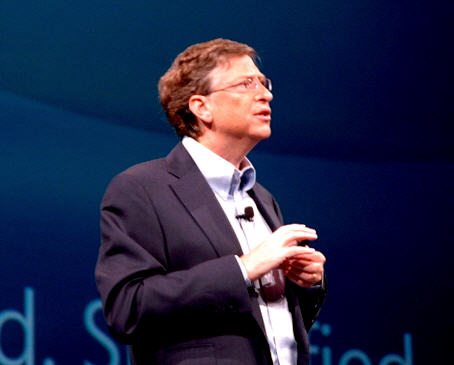Microsoft's 'click to communicate' for the Windows world

At the Bill Graham Civic Auditorium, a stage where I last saw Bob Dylan perform, Bill Gates and Jeff Raikes ushered in the era of unified communications. The event started with a guitarist, using a guitar with Microsoft Unified Communications plastered on it, played a few notes to some rock music. Very underwhelming, even for the audience of customers of business partners.
But the assembled were in the arena to see the legendary Bill Gates on stage. He set the context for the general release of the new communications products, which have been telegraphed for the last few years, and described them having an impact as profound as the shift from the typewriter to the word processor. Jeff Raikes, the president of the Microsoft Business Division who joined the company in 1981, said, "The new way to communicate starts today. We are transforming business communications as fundamentally as email did in the 1990s." Sounds similar to what companies such as Cisco and Avaya have been preaching.
Indeed, Microsoft sees a huge opportunity to become a dominant software communications platform, building on the success of SharePoint collaboration server. It's basically a major enhancement to the Windows platform, deeply integrating "click to communicate" with identity, presence and conferencing services into Microsoft Office applications. "Our vision is simple--increase productivity through communications convergence," Raikes said. Microsoft Dynamics and ERP products from company will also have the click to communicate capabilities, he said.
"In three years 100 million people will be able to click to communicate and VoIP will be 50 percent cheaper," Raikes stated. He said that 150 customers are running on Microsoft VoIP and Unified Communications products. "We estimate 25 to 30 percent cost savings over traditional approaches," Raikes added.
Microsoft has also focused as usual on building out its ecosystem, with 15 new devices that work with the software and support from Dell, HP, and SAP, which will presence-enable Duet. "For every $1 of value, partners will add $3," Raikes said. That's as long as customers are willing to pay for the solutions, and for Microsoft shops it's far more of a no-brainer than Vista.
Telephony providers Nortel, Ericsson and Mitel signed up to build products and services on top of Microsoft's Communication Server 2007.
Demos of the Unified Communications platform were impressive, with presence baked in as a backbone for working with other people. For companies "This is a multi-year, multi-dimensional commitment on behalf of Microsoft and our industry partners," Raikes said.
Gates and Raikes were on stage together discussing how some customers have benefited from unified communications solutions. They have been working together for more than 25 years, so the was a bit artificial to have teeing up their talking points in their chat.
When Gates is leaves his day-to-day duties next year, his grand vision of "natural" computing, with touch, speech, digital ink and everything digital will be unfulfilled. The Unified Communications platform is a step forward, and it will at least prop up the Windows platform for another round as the more swift upstarts attempt to outwit the giant.
